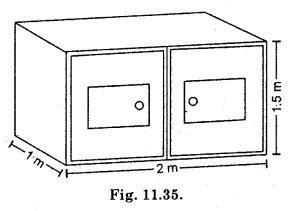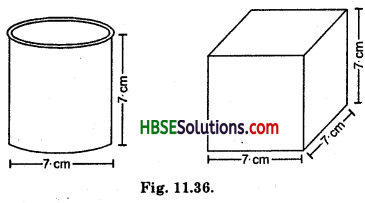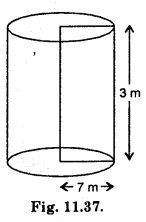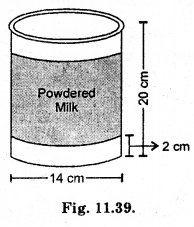Haryana State Board HBSE 8th Class Maths Solutions Chapter 11 Mensuration Ex 11.3 Textbook Exercise Questions and Answers.
Haryana Board 8th Class Maths Solutions Chapter 11 Mensuration Exercise 11.3
Question 1.
There are two cuboidal boxes as shown in the adjoining figure. Which box requires the lesser amount of material to make ?

Solution:
(a) Length = 60 cm
Breadth = 40 cm
Height = 50 cm
Total surface area of cuboidal boxes
= 2 (lb + bh + hl)
= 2 × (60 × 40 + 40 × 50 + 50 × 60)
= 2 × (240 + 200 + 300
= 2 × (740) = 1480 cm2.
(b) l = b = h = 50 cm
Total surface area of cuboidal boxes = 6l2
= 6 × (50)2 = 6 × 2500
= 15000 cm2
Hence (a) box requires the lesser amount of material to make.
Question 2.
A suitcase with measures 80 cm × 48 cm × 24 cm is to be covered with a tarpaulin cloth. How many metres of tarpaulin of width 96 cm is required to cover 100 such suitcases ?
Solution:
Total surface area of cuboidal suitcase
= 2 (lb + bh + hl)
= 2(80 × 48 + 48 × 24 + 24 × 80)
= 2 × (3840 + 1152 + 1920)
= 2 × 6912
= 13824 cm2.
![]()
Question 3.
Find the side of a cube whose surface area is 600 cm2.
Solution:
The total surface area of cube = 6l2
600 cm2 = 6l2
\(\frac{600}{6}\) = l2
100 = l2
\(\sqrt {100}\) = l
10 = l
Hence the required side of a cube = 10 cm.
Question 4.
Rukhsar painted the outside of the cabinet of measure 1 m × 2 m × 1.5 m. How much surface area did she cover if she painted all except the bottom of the cabinet.

Solution:
l = 2 m, b = 1 m, h = 1.5 m
Lateral surface area of cuboidal cabinet
= 2 (l + b) × h
= 2(2 + 1) × 1.5
= 2 × 3 × 1.5 = 9 m2
Hence, required surface area covered = 9 m2.
![]()
Question 5.
Daniel is painting the walls and ceiling of a cuboidal hall with length, breadth and height of 15 m, 10 m and 7 m respectively. From each can of paint 100 m2 of area is painted. How many cans of paint will ‘she need to paint the room ?
Solution:
l = 15 m, b = 10 m, h = 7 m
Lateral surface area of cuboidal classrom
= 2 (l + b) × h
= 2(15 + 10) × 7
= 2 × 25 × 7 = 350 m2
Area of ceiling = l × b
= 15 × 10 = 150 m2
Hence, the total area of painted wall and ceiling
= 350+ 150 = 500 m2
Since each can of paint covers 100 m2 of area
Hence 500 m2 of area needed can = \(\frac{500}{100}\) = 5
Hence, the required 5 cans of paint cover 500 m2.
Question 6.
Describe how the two figures at the right are alike and how they are different. Which box surface area ?

Solution:
Lateral surface area of cylinder
= 2 × \(\frac{22}{7}\) × \(\frac{7}{22}\) × 7
[where = 7 cm
∴ r = \(\frac{7}{2}\) cm
h = 7 cm]
= 154 cm2
Lateral surface area of cube
= 4l2 [where l = side = 7 cm]
= 4 × (7)2
= 4 × 49 = 196 cm2
Hence cubical box has larger lateral surface area.
![]()
Question 7.
A closed cylindrical tank of radius 7 m and height 3 m is made from a sheet of metal. How much sheet of metal is required ?

Solution:
Total surface area of cylindrical tank
= 2πr (r + h)
= 2 × \(\frac{22}{7}\) × 7 (7 + 3)
= 2 × 22 × 10 = 440 m2
Hence, the required metal sheet = 440 m2.
Question 8.
The lateral surface area of a hollow cylinder is 4224 cm2. It is cut along its height and formed a rectangular sheet of width 33 cm. Find the perimeter of rectangular sheet ?
Solution:
Width of rectangular sheet = 33 cm
Hence, height of cylinder = 33 cm
The lateral surface area = 2πrh
4224 = 2 × \(\frac{22}{7}\) × r × h
4224 = 2 × \(\frac{22}{7}\) × r × 33
\(\frac{4224 \times 7}{2 \times 22 \times 33}\) = r
20.36 = r
∴ Radius = 20.36
d = 2 × 20.36 = 40.72 cm
Now l = 40.72 and b = 33 cm
Hence, perimeter of rectangular sheet
= 2(l + b)
= 2 × (40.72 + 33)
= 2 × 73.22 = 147.44 cm.
![]()
Question 9.
A road roller takes 750 complete revolutions to move once over to level a road. Find the area of the road if the diameter of a road roller is 84 cm and length is 1 m.

Solution:
Diameter of road roller = 84 cm
∴ r = \(\frac{84}{2}\) = 2 cm
l = h = 1 m = 100 cm
Total surface area of road roller = 2πr(r + h)
= 2 × \(\frac{22}{7}\) × 42 × (42 + 100)
= 2 × 22 × 6 × 142
= 37488 cm2
Hence, the area of road
= 37488 × 750
= 28116000 cm2
\(\frac{28116000}{100×100}\) = 2811.6 m2
Hence, the required area of road = 2811.6 m2.
Question 10.
A company packages its milk powder in cylindrical container whose base has a diameter of 14 cm and height 20 cm. Company places a label around the surface of the container (as shown in figure). If the label is placed 2 cm from top and bottom, what is the area of the label ?

Solution:
r = \(\frac{d}{2}\) = \(\frac{14}{2}\) = 7 cm
h = 20 cm
Top and bottom height = 2 + 2 = 4m
Hence required height of cylindrical powdered milk
= 20 – 4 = 16 cm
Lateral surface area of cylindrical powdered milk
= 2πrh = 2 × \(\frac{22}{7}\) × 7 × 16
= 2 × 22 × 16 = 704 cm2
Hence the required area of label = 704 cm2.